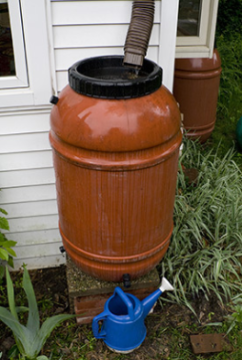RAIN BARRELS: A BETTER WAY TO MANAGE STORMWATER

What is a Rain Barrel?
A Rain Barrel collects stormwater as runoff from rooftops and temporarily stores it for later use. Rain barrels are typically installed on the ground near a building and are connected to one of its downspouts. Using a rain barrel is a simple way for homeowners to contain a small portion of the precipitation from their roofs and reuse it in a sustainable way. Not only are rain barrels inexpensive, but they are also easy to install and require little maintenance.
Benefits of Rain Barrels
Rain that runs off roofs and other surfaces can seep into the ground or travel across the land, often picking up sediment and contaminants along the way. Much of this runoff flows into a storm drain and ultimately enters nearby tributaries. Why not recycle this water and put it to a more practical use? Rain barrels enable homeowners to collect a portion of this water and use it to water plants, gardens, etc. Reusing rainwater not only helps conserve water and save on your household bill, it slows runoff, lessening the impact on the collection system. This can reduce flooding potential as well as Combined Sewer Overflows (CSOs), helping to protect our watersheds and water quality.
Rain Barrel Installation*
- Take a close look at your property and evaluate site-specific drainage conditions and safety issues. Sketch a detailed map of the proposed area that includes all applicable factors.
- Determine the best location for your barrel and create a plan for assembly, connection and overflow drainage.
- Obtain all tools and supplies needed for installation.
- Construct and install your rain barrel by performing the following steps: creating an inlet; accommodating overflow; building a stable foundation; cutting the downspout; attaching the barrel; and drilling an outlet.
Upon completion of these steps, your barrel should be ready for use! Be sure to properly maintain your rain barrel (and the entire stormwater system on your property) to prevent runoff problems in the future.
* For safety guidelines, supply list, detailed project instructions and maintenance, refer to downspout disconnection and rain barrel information on our website at: pennsylvaniaamwater.com.